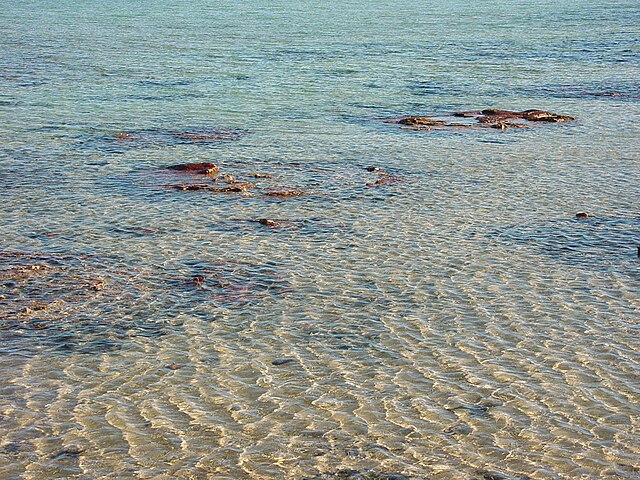Loading AI tools
From Wikipedia, the free encyclopedia
Shallow water marine environment refers to the area between the shore and deeper water,[clarification needed] such as a reef wall or a shelf break. [clarification needed]This environment is characterized by oceanic, geological and biological conditions, as described below. The water in this environment is shallow and clear,[1][clarification needed] allowing the formation of different sedimentary structures, carbonate rocks, coral reefs, and allowing certain organisms to survive and become fossils.
This article needs attention from an expert in Limnology and Oceanography. The specific problem is: Scope poorly defined. (July 2024) |

The sediment itself is often composed of limestone, which forms readily in shallow, warm, calm waters. While siliciclastic and carbonaceous sediments can coexist, shallow marine environments can also contain only one or the other. Shallow water marine sediment primarily features larger grain sizes because smaller grains have washed out to deeper water. Within carbonaceous sedimentary rock, evaporite minerals such as gypsum, anhydrite, and halite may be present.[2] The most common evaporite minerals found within modern and ancient deposits are gypsum, anhydrite, and halite. These minerals can occur as crystalline layers, isolated crystals, or clusters of crystals.[2]
Approximately 75% of surface sediments are in shallow marine environments, holding most Phanerozoic and Precambrian sedimentary rock.[3] This is visible in the North American and Caribbean regions. However, shallow marine sediment quantity varies significantly over geologic time due to supercontinent breakup and shifting tectonic plate processes.[4]

Shallow marine environments are characterized by various types of sedimentary structures, including:[1]
Carbonaceous sedimentary rock in SMEs contain significant amounts of non-skeletal matter along with siliciclastic or chemical constituents and can exhibit a range of sedimentary structures, including:[1]
Shallow marine environments are typically characterized by clear and shallow water. The distributional patterns of marine organisms in these environments can be used to define different types of shallow marine environments based on temperature, which can also provide insights into past patterns in paleolithic zones.[5]
The boundaries between different shallow marine environment types in terms of climatic zones are not always agreed upon. However, three major criteria are used to define SME types: faunal provinces, faunal elements, and latitude.[5]
Carbon dioxide is removed from the atmosphere when it dissolves in seawater and turns into carbonic acid. The acid then weathers rocks, creating bicarbonate and other ions. Calcium carbonate is a precipitate from calcium and the bicarbonate ions, while the carbon is precipitates as limestone.[1] Many shallow marine environments are associated with carbonate factory zones, where processes that remove CO
2 from the water change bicarbonate ions into carbonate ions, supporting lime precipitation. These processes include increasing temperature, intense evaporation, and mixing water that is high in CO
3 and low in calcium cations with seawater.
Over geologic time, the composition of limestone has changed from calcite-rich to aragonite-rich. This change is influenced by the presence of magnesium ions, which can inhibit calcite precipitation. Aragonite and calcite have the same chemical formula but a different crystal system, although aragonite is less prone to magnesium inhibition. Changes in the Mg/Ca ratio over geologic time, influenced by seafloor spreading and tectonic plate movement, have also increased aragonite abundance.[1]

Shallow marine environments, particularly the intertidal zone, are home to a diverse range of organisms, including starfish, sea anemones, sponges, marine worms, clams, mussels, predatory crustaceans, barnacles and small fish.[6]
Hydrozoa, also known as hydroids, inhabit SMEs and feed on surrounding algae and zooplankton. Species of isopods and amphipods are found in intertidal zones, creating complex burrows and surface tracks in the sediment. Brittle stars may bury themselves in sediment with their arms exposed.[7]
SMEs are characterized by carbonate reefs, which support many species. Estimates suggest that coral reefs alone may host between 1-9 million species. The three main types of reef formations are:[8]
Organisms that inhabit these reefs include red algae, green algae, bivalves and echinoderms. Many of these organisms contribute to reef formation.[1] Furthermore, unicellular dinoflagellates live in coral tissues, engaging in a mutualistic relationship where they provide corals with essential organic molecules.[6]

The majority of the fossil record has been discovered in lithified SMEs, which were once home to diverse organisms. Many of these fossils date to periods when much of the Earth was covered in shallow seas.
Several types of fossils can be found in these environments, including:
Seamless Wikipedia browsing. On steroids.
Every time you click a link to Wikipedia, Wiktionary or Wikiquote in your browser's search results, it will show the modern Wikiwand interface.
Wikiwand extension is a five stars, simple, with minimum permission required to keep your browsing private, safe and transparent.